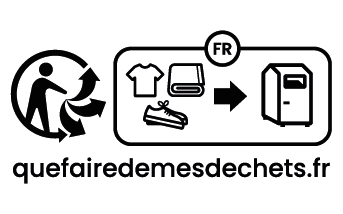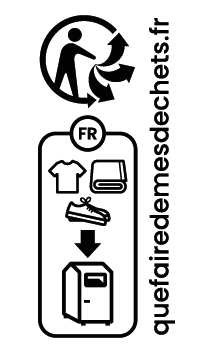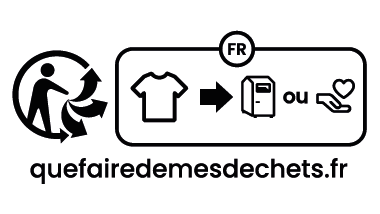Unveiling the New Compulsory Triman Label and Textile Recycling Information in France
Triman/Info‑tri labelling is now mandatory: what it means for brands and importers.
The context: the AGEC law, the principle of Extended Producer Responsibility (REP), and Refashion
To move towards a circular economy, the AGEC law aims for better waste valorization. One of the prerequisites is improved waste sorting so that they can be directed to appropriate recycling or reuse processes.
For this purpose, consumers need to be better informed about the sorting rules for used products they wish to dispose of.
That is why the AGEC law, in its Article 17 further defined by an application decree, requires the mandatory display of the following elements on all products**: the Triman logo accompanied by the info-tri sorting signage**, which indicates the sorting methods applicable to the specific waste category. The combination of these two elements, which the law asserts as inseparable, is commonly referred to as "info-tri" (sorting-info), "signalétique Triman" (Triman signage) or "signalétique info-tri" (info-tri sorting signage).
The eco-organizations of each Extended Producer Responsibility (EPR) sector were tasked with developing appropriate signage for products within their scope.
💡 Extended Producer Responsibility (EPR) sectors
In France, under Extended Producer Responsibility (EPR), any entity that imports, manufactures, and/or distributes a product is responsible for its end-of-life management.
The collection, reuse, and recycling of waste from a product are thus financed and implemented by those who put the product on the market.
In this context, brands have two options:
- Manage the end-of-life of their products themselves.
- Join sector-based eco-organizations that coordinate and financially support the stakeholders involved in the end-of-life management of the products. Brands then finance this organization through an eco-contribution.
In practice, the second option has been widely adopted.
There are 25 sectors, corresponding to major product categories, including 11 that were created by the AGEC law. For each sector, an eco-organization is approved by the authorities and committed to prevention, collection, and recycling obligations defined by law in a specification.
Among these sectors, the Textile sector, known as the TLC sector, includes apparel, household linen, and footwear.
The eco-organization responsible for the Textile EPR sector is Refashion (formerly Eco-TLC). In compliance with the AGEC law, Refashion has developed a Triman signage, which we will explore in the following paragraphs.
Refashion has also been involved in other articles of the AGEC law. To learn more, you can refer to our articles on eco-modulation (article 62) and product environmental qualities and characteristics sheets (Article 13).
To find out about all the measures concerning consumer information resulting from the AGEC and Climate and Resilience laws, we invite you to read this article.
Products covered by Refashion's mandatory sorting information
The Triman signage must appear on the following items:
- All clothing textiles, except for all-leather products, leather goods, and items made of natural fur.
- All shoes, except for certain special shoes (medical, sports).
- All household linen, except for household textiles or furnishing textiles.
The detailed list of products covered and exceptions can be found in Refashion's downloadable nomenclature.
The responsibility for implementing the new signage lies with the entities that place these products on the market, including manufacturers, contractors, importers, or distributors (own brand).
Please note that packaging falls under the Citeo info-tri sorting signage.
The Triman and sorting signage to be displayed for apparel and footwear products
The reference info-tri sorting signage
The signage developed by Refashion is presented in the following way (both in vertical and horizontal versions):


It comprises three main elements:
- The Triman logo: a character with three arrows, encouraging sorting.
- The informative cartouche about sorting instructions: the type of product, an arrow pointing to the voluntary drop-off point (depicted clothing container), the letters "FR" indicating that this instruction is valid in French territory.
- The URL of the ADEME simulator: it corresponds to a search engine that, for any entered product/waste and address, provides corresponding sorting instructions, a map of nearby collection points, and other information and advice.
Possible variations allowed by Refashion:
Variations of the basic signage described above can be used.
1. Product category pictograms
Only one category of TLC (clothing, linen, or shoes) can be indicated in the info-tri sorting cartouche, depending on the brand's preference :



2. Additional drop-off points
The info-tri sorting cartouche may include, in addition to the reference drop-off point (clothing container):
- One additional drop-off point: associations/NGOs.
- Two additional drop-off points: associations and voluntary stores, noting that only brands that have set up in-store collection points can use this variation.


3. Additional text
For products placed on the market exclusively in France:
- The phrase “Vos textiles et chaussures ont de l’avenir, donnez-les !” (Your textiles and shoes have a future, donate them!) can be added above the chosen signage.
- If the info-tri sorting cartouche includes multiple drop-off points, a mention indicating their names can be added (with or without the phrase "Vos textiles et chaussures ont de l’avenir, donnez-les !").



You can find all the symbol combinations and download them in the documents available on the Refashion website.
The graphic guidelines for Refashion's sorting signage:
Refashion has provided graphic guidelines that govern the use of its info-tri sorting signage in terms of dimensions, typography, and colors.
- The minimum dimensions are as follows (invert length and height if the logo is used in its vertical version):
- 1 cm in height, or 0.6 cm in case of technical difficulty
- 7 cm in length
- The Poppins typography is used, in its Light, Medium, and Semi-bold variations.
- The background must allow perfect readability of the info-tri sorting information, and if not, it must be applied in its version with a white background.
- Black and white are recommended, but colors can be used as long as the signage remains monochrome.
- The pictograms present in the cartouche cannot be modified.
For more details, we invite you to refer to the documents available on the Refashion website.
Modalities of displaying the Triman and sorting information
The methods of displaying the info-tri sorting signage (physical format, digital format) are also strictly regulated by the regulations.
The application decree of Article 17 of the AGEC law, published on June 29, 2021, specifies that the signage must be available to the consumer at the time of purchase in a physical format. This can be:
- On the product (sewn label, printed, or embroidered)
- On the product's temporary label known as "hangtag"
- On the product's packaging
- In the form of a sticker
The signage can be communicated to the consumer in a digital format (web page, product sheet...) only in the following cases:
- If the largest side of the article has an area smaller than 10 cm² AND the article is not provided with documents, the entire signage can be digital.
- If the largest side of the article has an area between 10 cm² and 20 cm², only the Triman logo must appear physically. The info-tri sorting cartouche can be digital.
For example, this applies to fine lingerie products.
Refashion emphasizes that if the product is sold with elements that have different sorting instructions, the signage specific to each element must appear, for instance, the CITEO info-tri sorting information for packaging or labels, and the Refashion info-tri sorting information for the textile article, each associated with its Triman logo.
Timeline for the implementation of the new Triman and sorting signage
The new Triman signage became mandatory for the textile sector on February 1, 2023, one year after its validation by the ministries of the economy and ecological transition.
However, there is a grace period for products that were manufactured or imported before February 1, 2023: they can be placed on the market without the info-tri sorting information until August 1, 2023, at the latest.
For packaging, the CITEO info-tri sorting information became mandatory on September 9, 2022, and the grace period for stock clearance ends on March 9, 2023.
Penalties for the absence of sorting information on products
Failure to comply with the info-tri sorting information obligation is subject to a fine of up to €15,000 for a legal entity.
The AGEC law (Anti-Waste for a Circular Economy) aims to promote the ecological transition of consumption and production methods, particularly by improving waste recovery.
To encourage consumers to sort their waste and inform them about the sorting methods for used products, its Article 17 provides that all producers must display signage on their items, indicating the sorting or disposal rules for the resulting waste, always accompanied by a Triman logo.
Regarding the apparel industry, Refashion, the approved eco-organization, has established a sorting information that must appear on products, accompanied by the Triman symbol.
This article unveils which products are in the scope, what are the graphic guidelines, explains the application procedures, and implementation timeline for the new apparel and footwear recycling information.
white paper
replay
Summary
Fill out the form below.


.avif)

.avif)